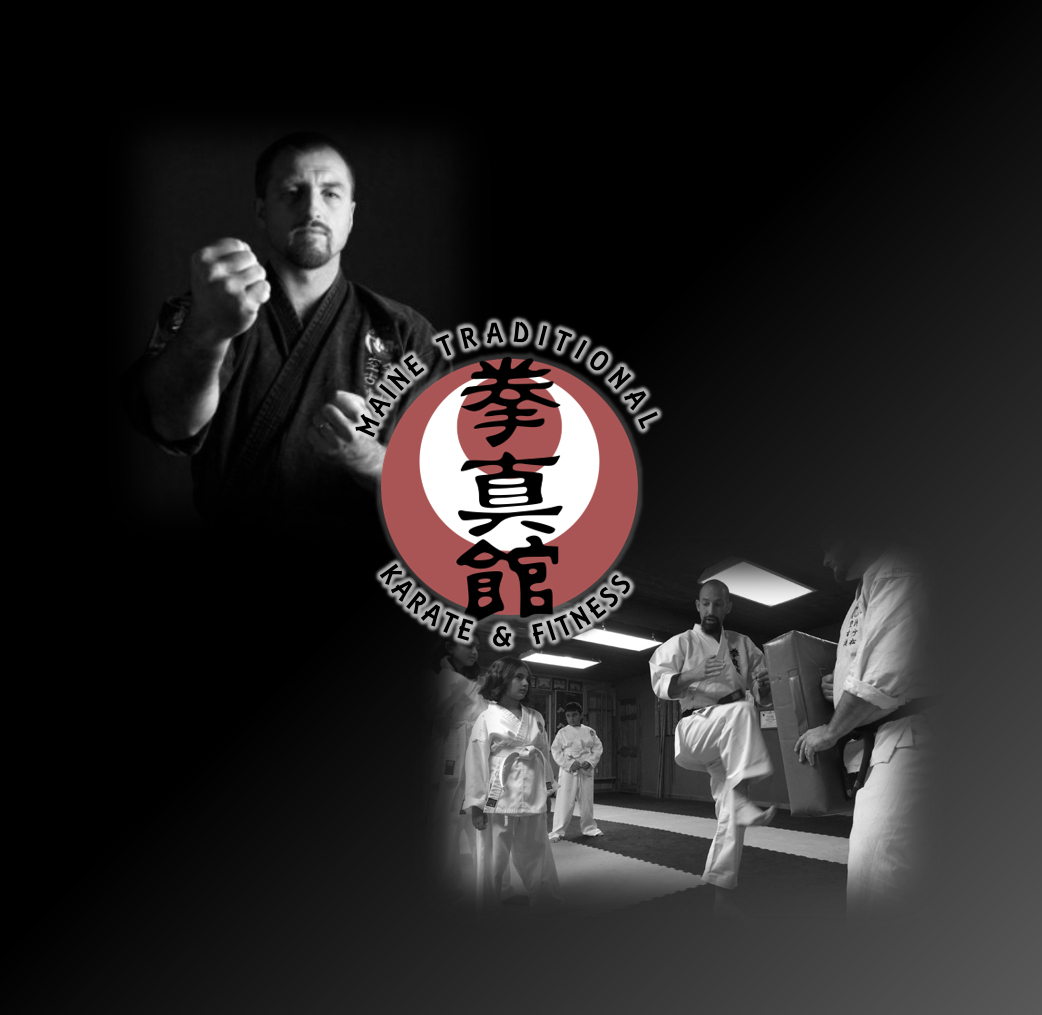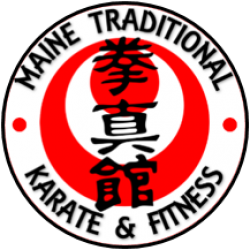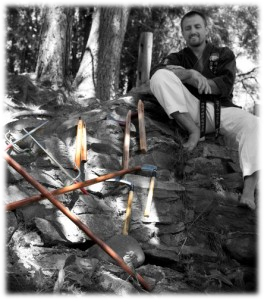 Kobudo is Japanese for “ancient martial way” and is generally used to refer to weaponry. As a traditional Okinawan martial arts style, Shorin Ryu Karate does train with the original kobudo of the island nation. The weapons were often fashioned from tools and items readily available at the time.
Kobudo is Japanese for “ancient martial way” and is generally used to refer to weaponry. As a traditional Okinawan martial arts style, Shorin Ryu Karate does train with the original kobudo of the island nation. The weapons were often fashioned from tools and items readily available at the time.
The basic principles of kobudo training apply in a large variety of situations. Whereas you may not have an actual “Bo staff” readily handy, it isn’t unreasonable to imagine finding a mop or broom nearby! Karate may mean “empty hand,” but we train to prepare for a variety of situations.
 Nitan Bo
Nitan Bo  Bo
Bo 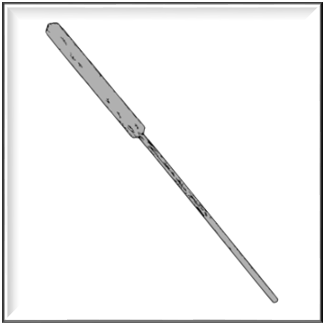 Eku
Eku  Tonfa
Tonfa  Nunchaku
Nunchaku  Kama
Kama  Sai
Sai 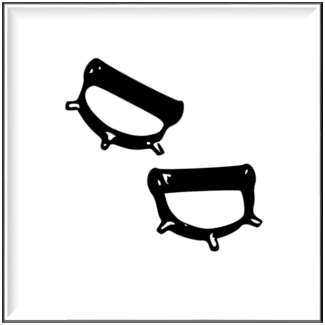 Tekko
Tekko  Nunti Bo
Nunti Bo 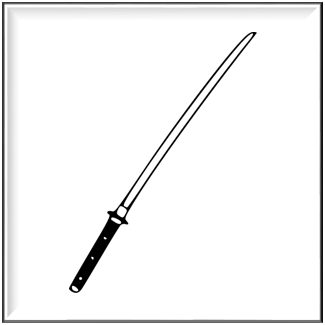 Katana
Katana  Tinbe Rochin
Tinbe Rochin Nitan Bo
Wood
History:
The Nitan Bo is a unique weapon comprised of two short sticks. It is part of the traditional Okinawan Kobudo or ancient weapons system. The “Ni” in the name indicates “two” and the weapon could be considered as two halves of a broken bo staff. The techniques applied with Nitan Bo are very similar to the Filipino martial arts involving Eskrima.
Traditional use:
Nitan Bo would consist of virtually any pairing of sticks to effectively act as weapons. These could have been tool handles, a broken bo staff or even actual sticks. Readily available and adaptable in most situations.
Current use:
Nitan Bo by that name are not common today. Similar weapons are used as a security tool. Batons are used by police forces and security guards alike in situations where non-lethal force may be necessary.
Bo
Wood
History:
The Bo is one of the five weapons systematized by the early Okinawan developers of the style known as te (hand). In feudal Japan it was part of the bugei (early Japanese martial arts) and was used by samurai, priests, and commoners alike. Its six foot length made it an apt weapon against swordsman, disarming the opponent while allowing the user to remain at a safe distance.
Traditional use:
The Bo evolved from a pole lanced across the shoulders to carry water or other loads, like fruits or vegetables. As a fighting instrument, it allowed blocking and striking against a range of weapons.
Current use:
Now part of the budo, the Bo is still used in kata performance. Physical conditioning with the Bo improves balance and upper body strength. Remember a Bo can be found anywhere; a pool stick, a tree limb, a broom, a mop, etc.
Eku
Wood
History:
This was and still is today used as nothing more than a boat oar. Because the Okinawans were fisherman this was a common device that was found around the beaches.
Traditional use:
Very effective against the samurai warrior because of the distance they would be able to keep the samurai away from them. The techniques would involve a lot of kicking the blade of the eku while in the sand throwing the sand into to eyes of their opponent blinding them and then they would easily be able to beat the samurai.
Current use:
Mainly used by high level Kobudo practitioners and is not very often seen. Training with the Eku develops coordination, upper body strength, and quickness. The same oar as we use in Kenshin Kan is the same oar they still use in the dragon boat races in Okinawa.
Tonfa
Wood
History:
Developed as a weapon by the Okinawans, specifically for use in conjunction with karate. Two Tonfa were often used simultaneously, and were very efficient against armed assailants.
Traditional use:
Originally a bean or rice grinder handle, the Tonfa’s circular movements as a farm implement evolved into its rotating strikes as a weapon. The side of the Tonfa was used for blocking, and the ends for direct punches.
Current use:
Now an advanced karate training aid, the Tonfa aids in development block-and-strike strategies and upper-body strength. It is also used in many police departments throughout the United States.

Nunchaku
Wood
History:
Developed in the 17th century by Okinawans after the Japanese gained occupation of their land, the nunchaku was one of many harmless looking weapons implemented at the time. The two equal sections were originally held together by horse hair and could be used against armed or unarmed assailants.
Traditional use:
Originally an agricultural tool used for threshing grain, rice or soybeans. As a weapon, it was used in conjunction with various stances and techniques. The sticks could be used for spearing or striking, and the horse hair rope could choke , block, or trap.
Current use:
Popular weapon for demonstrations. It is also used as a weapon of self-defense by karate stylists and some law enforcement agencies.
Weapon Anatomy:

Kama
Metal
History:
In 1470, when traditional weapons were confiscated by the Japanese military, Okinawan commoners utilized the Kama as a fighting blade, often attaching a chain to the base for greater reach. This longer weapon was known as a kusarigama.
Traditional use:
The Kama was originally used for cutting grass or sugar cane. In close range fighting, the sickle could be used to trap an opponent’s weapon, or for striking.
Current use:
The Kama is most commonly used in Kata competition and demonstrations although it is also still used in Okinawa today as a farming tool. The forms include circular movements which improve blocking and countering techniques. This weapon will strengthen the wrist and forearm.
Sai
Metal
History:
Present in Okinawan and other Asian weapon arsenals, the Sai was used to stab, block, trap and punch. Practitioners often carried a Sai in each hand, and a spare at the belt. The Okinawans would also throw the weapon.
Traditional use:
The Sai is believed to have originated from basically nothing more than a pitchfork. As a weapon, it was used in conjunction with various karate stances and techniques, and in defense against sword attacks.
Current use:
With sometimes dulled points, the Sai is now a karate training weapon. It tests accuracy in striking and quick counter techniques. It also develops strong shoulder! forearm and wrist strength.
Weapon Anatomy:
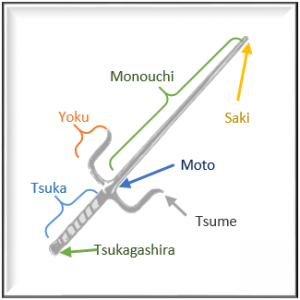
Tekko
Metal
History:
Used for easing the handling of horses harnessed to carriages.
Traditional use:
Developed from various sources depending on the type used. The tekko/metal knuckle-duster was used from the stirrups of a horse while the wooden tecchu is said to have come from the Okinawan fisherman. The fisherman used this instrument to assist with hauling their nets in order so that the coral would not tear the skin of their hands.
Current use:
Mainly used by high level Kobudo practitioners and is not very often seen. Training with the Tekko develops upper body strength, and quickness.
Nunti Bo
Metal
History:
Similar to a spear, but typically composed of a bo with a manji-shaped sai mounted on the end.
Traditional use:
It is believed that this was originally used as a fishing spear.
Current use:
The nunti bo is not a commonly used weapon in Kobudo and it is reserved for higher ranking black belts in kata.
Katana
Metal
History:
A traditional Japanese sword carried by the samurai class. During the Japanese Satsuma clan occupation of Okinawa the rules regarding weaponry prohibited non-warrior class civilians from carrying a personal weapon on them. The occupying military members carried katanas and civilians had little defense against them unless they creatively utilized Kobudo.
Traditional use:
Katanas were not common in Okinawan Kobudo usage largely due to the fact that it was illegal to carry them. Knowledge of the weapon was not prohibited, but effectively training with it would have been difficult due to the ban of war weapons for civilians.
Current use:
The katana today is a well known Japanese weapon that is reserved for training, ceremonial and competition purposes.
Tinbe Rochin
Metal
From article Tinbe-Rochin on Black Belt Wiki:
The Tinbe Rochin is a traditional Okinawan (Japan) Kobudo weapons combination consisting of a shield (tinbe) and short spear (rochin). The shield was often made from a large turtle shell or a farmer’s conical straw hat (that used the straw in order to trap an opponent’s weapon).
This weapon can be found in the Kubudo training (weapons training) of many different Karate styles. However, the Tinbe Rochin is less utilized than other better-known Kubudo weapons such as the Bo, Nunchaku, Sai, etc. The Tinbe Rochin is also used in weapon katas such as Kanegawa No Tinbe Kata. As with other sword/spear and shield weapons, the shield is primarily used to block/defend against oncoming strikes . The rochin/spear is primarily used to thrust and slash but is also used to block. Likewise there are some strike/attack techniques for the Tinbe or shield.
